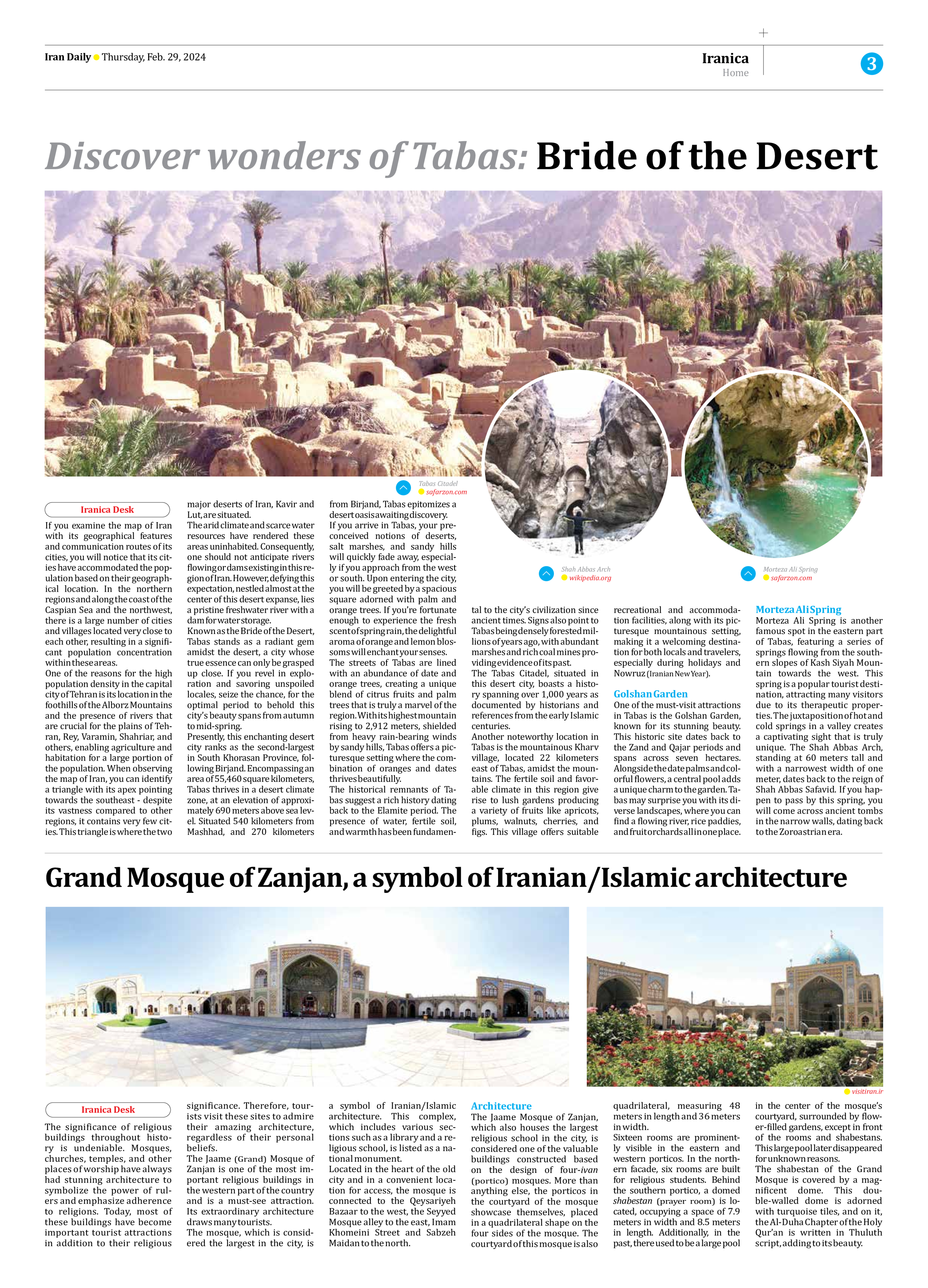
Discover wonders of Tabas: Bride of the Desert
If you examine the map of Iran with its geographical features and communication routes of its cities, you will notice that its cities have accommodated the population based on their geographical location. In the northern regions and along the coast of the Caspian Sea and the northwest, there is a large number of cities and villages located very close to each other, resulting in a significant population concentration within these areas.
One of the reasons for the high population density in the capital city of Tehran is its location in the foothills of the Alborz Mountains and the presence of rivers that are crucial for the plains of Tehran, Rey, Varamin, Shahriar, and others, enabling agriculture and habitation for a large portion of the population. When observing the map of Iran, you can identify a triangle with its apex pointing towards the southeast - despite its vastness compared to other regions, it contains very few cities. This triangle is where the two major deserts of Iran, Kavir and Lut, are situated.
The arid climate and scarce water resources have rendered these areas uninhabited. Consequently, one should not anticipate rivers flowing or dams existing in this region of Iran. However, defying this expectation, nestled almost at the center of this desert expanse, lies a pristine freshwater river with a dam for water storage.
Known as the Bride of the Desert, Tabas stands as a radiant gem amidst the desert, a city whose true essence can only be grasped up close. If you revel in exploration and savoring unspoiled locales, seize the chance, for the optimal period to behold this city’s beauty spans from autumn to mid-spring.
Presently, this enchanting desert city ranks as the second-largest in South Khorasan Province, following Birjand. Encompassing an area of 55,460 square kilometers, Tabas thrives in a desert climate zone, at an elevation of approximately 690 meters above sea level. Situated 540 kilometers from Mashhad, and 270 kilometers from Birjand, Tabas epitomizes a desert oasis awaiting discovery.
If you arrive in Tabas, your preconceived notions of deserts, salt marshes, and sandy hills will quickly fade away, especially if you approach from the west or south. Upon entering the city, you will be greeted by a spacious square adorned with palm and orange trees. If you’re fortunate enough to experience the fresh scent of spring rain, the delightful aroma of orange and lemon blossoms will enchant your senses.
The streets of Tabas are lined with an abundance of date and orange trees, creating a unique blend of citrus fruits and palm trees that is truly a marvel of the region. With its highest mountain rising to 2,912 meters, shielded from heavy rain-bearing winds by sandy hills, Tabas offers a picturesque setting where the combination of oranges and dates thrives beautifully.
The historical remnants of Tabas suggest a rich history dating back to the Elamite period. The presence of water, fertile soil, and warmth has been fundamental to the city’s civilization since ancient times. Signs also point to Tabas being densely forested millions of years ago, with abundant marshes and rich coal mines providing evidence of its past.
The Tabas Citadel, situated in this desert city, boasts a history spanning over 1,000 years as documented by historians and references from the early Islamic centuries.
Another noteworthy location in Tabas is the mountainous Kharv village, located 22 kilometers east of Tabas, amidst the mountains. The fertile soil and favorable climate in this region give rise to lush gardens producing a variety of fruits like apricots, plums, walnuts, cherries, and figs. This village offers suitable recreational and accommodation facilities, along with its picturesque mountainous setting, making it a welcoming destination for both locals and travelers, especially during holidays and Nowruz (Iranian New Year).
Golshan Garden
One of the must-visit attractions in Tabas is the Golshan Garden, known for its stunning beauty. This historic site dates back to the Zand and Qajar periods and spans across seven hectares. Alongside the date palms and colorful flowers, a central pool adds a unique charm to the garden. Tabas may surprise you with its diverse landscapes, where you can find a flowing river, rice paddies, and fruit orchards all in one place.Morteza Ali Spring
Morteza Ali Spring is another famous spot in the eastern part of Tabas, featuring a series of springs flowing from the southern slopes of Kash Siyah Mountain towards the west. This spring is a popular tourist destination, attracting many visitors due to its therapeutic properties. The juxtaposition of hot and cold springs in a valley creates a captivating sight that is truly unique. The Shah Abbas Arch, standing at 60 meters tall and with a narrowest width of one meter, dates back to the reign of Shah Abbas Safavid. If you happen to pass by this spring, you will come across ancient tombs in the narrow walls, dating back to the Zoroastrian era.







